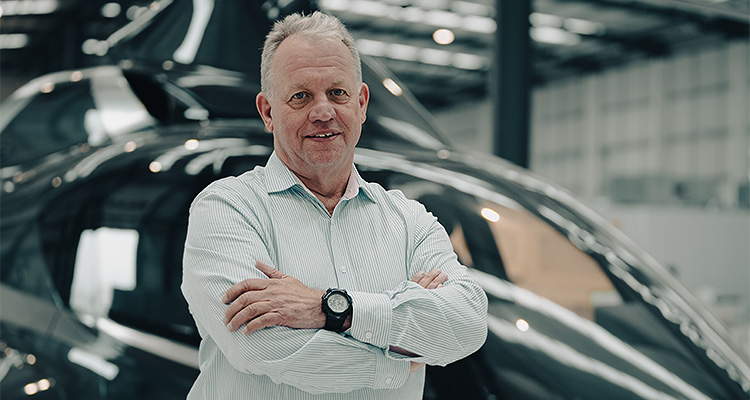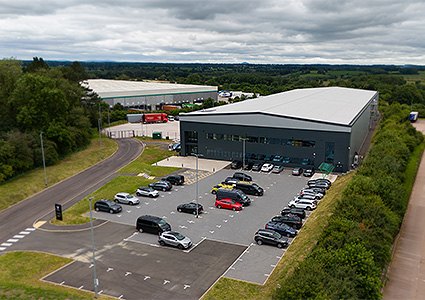
How Hill Helicopters is set to transform the helicopter market
Hill Helicopters (Hill) was born of a childhood dream. Inspired by the supersonic stealth helicopter that featured in the TV series Airwolf, Dr Jason Hill, Founder and Chief Engineer dreamt of flying helicopters with supercar styling, performance, and comfort. CEO Peter Teare explains how when Jason realized his dream aircraft didn’t exist, he made it his ‘life-long mission to design and build it himself’.
“After studying mechanical engineering, and then pursuing a doctorate in computational aerodynamics, Jason honed his expertise working for a leading military and commercial helicopter manufacturer. The early designs of the HX50 emerged once Jason had set up his engineering consultancy business. By 2020, the HX50 project was sufficiently advanced and had gained enough interest and support among other, equally frustrated helicopter pilots for Jason to accept advance orders for the HX50,” Peter adds.
To explain a little about the business model which is unusual – each Hill Helicopter customer pays a non-refundable deposit, which goes towards funding design and development. This means each one of them is literally invested in the success of the venture.
The Hill helicopter is set to revolutionize the rotary aircraft marketplace, and will be available in two versions, the HX50 for private and personal use and the HC50 which will be certified for commercial use. It has five seats, will cruise at 140 knots (160 miles per hour) and has a range of 700 nautical miles (805 statute miles), out-performing all single-engine helicopters in its class.
Peter highlights some of the details that set Hill’s models apart. “The HX50 brings supercar styling, performance and comfort to general aviation for the first time. At the same time, we are dramatically reducing costs of helicopter ownership and operation. The HX50 has a base price of £595,000 – an entry price point for helicopter ownership which no other manufacturer can compete with for an aircraft in its class.”
Peter goes on to explain how achieving such strikingly competitive pricing while not compromising on design is possible: “The key is our integrated supply chain strategy. Ninety-five percent of what goes into the HX50 is manufactured in our own production factory in Stafford. This eliminates multiple layers of supplier margins. Aerospace is a sector dominated by a small number of suppliers who can command very high prices.
 “By making almost everything ourselves to our own design, in our own factory with our own fantastic workforce we can achieve all the savings we need to reduce the costs of helicopter ownership and operation. We will never compromise on quality or safety to save costs. We simply don’t need to.”
“By making almost everything ourselves to our own design, in our own factory with our own fantastic workforce we can achieve all the savings we need to reduce the costs of helicopter ownership and operation. We will never compromise on quality or safety to save costs. We simply don’t need to.”
Keeping most of the manufacturing in-house also reduces the lead times that would be typical when relying on suppliers. The HX50 also overcomes some common problems experienced by owners and operators. Peter elucidates: “It eliminates the massive depreciation suffered by owners of helicopters with a mandatory 12-year aircraft and engine overhaul requirement.
“A typical 12-year inspection for a comparable aircraft will likely cost at least £300,000 depending on engine condition. In contrast, the airworthiness of parts and components of the HX50 are determined ‘on condition’ and not by age. Because each component of the HX50 has a long 5000-hour ‘time between overhauls’ with no hard calendar inspection trigger, HX50 owners will not suffer the same crippling operating costs and depreciation as other helicopter owners.”
Another area where the company is staying ahead of the curve to meet demands from both private and commercial customers is in sustainability. Making the HX50 compatible with biofuel was essential. Peter expands: “First and foremost, our customers have told us that they want the option. More generally, the likely impact of environmental regulation on the aviation sector is significant – as recently evidenced in France with its ban of short haul commercial flights. An aircraft and engine that does not provide biofuel optionality is not a solution for commercial operators.”
There has already been a substantial response to this transformative offering. Hill has already received over 1300 advanced orders, representing a sales order book exceeding £500 million. Peter notes the depth of engagement achieved with these customers: “Since most of them are existing helicopter pilots or owners, they continually provide valuable feedback to the design team.” Through the Hill Community app, regular video updates and periodic video cast, communication is in depth and ongoing throughout the process.
“The initial development of the HX50 received a government grant from Innovate UK, but as the business scales up towards full production we will require more space and more highly skilled staff – up to 1000 over three years. The company is being courted by governments from around the world seeking to capitalize on the economic opportunities Hill present.” As Peter puts it: “Time will tell whether our new government will offer any engagement and support to keep a Great British engineering success story in Britain.”
In concluding, Peter hints at ambitions that go beyond a revolutionary helicopter. “In developing the HX50, we have created a scalable technology platform that reaches beyond small, private helicopters. The methods could eventually be deployed into larger helicopters as well as fixed wing aircraft.” He reaffirms the business’ current priorities remain “getting the HX50 in production and starting customer deliveries.”
The HX50 has become the world’s fastest selling helicopter, even before its first flight. It will be fascinating to watch its evolution and see the heights of success that the business can achieve.